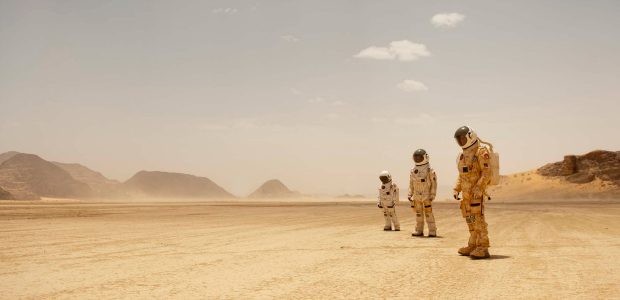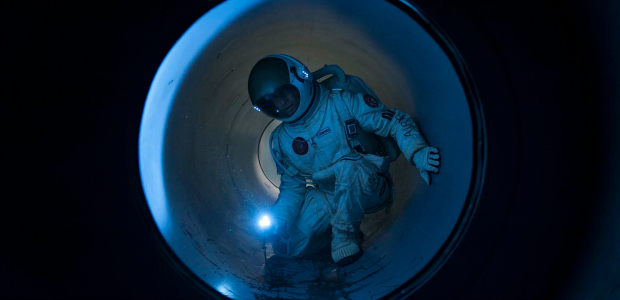
Thirty-eight years from page to screen
Most feature films undergo a gestation period lasting several years, and The Last Days On Mars is no exception. However, the seeds of this particular film were first planted as long ago as 1975. The short science fiction story, The Animators, by acclaimed author Sydney J Bounds, was originally published that year as part of the Fontana paperback anthology, Tales of Terror from Outer Space. I first read the story in the early 1980s and, even today, it remains one of the most evocative and creepy short stories I’ve ever read.
In brief, Syd’s story takes place during the first manned expedition to Mars. The mission goes catastrophically wrong when an overly curious astronaut-geologist, Pugh, is killed during a cave-in. What appears at first to be a tragic accident takes on a more sinister edge when the mission commander, Brunel, suspects the cave-in may have been deliberately engineered; a man-trap, left behind on the planet’s surface by forces unknown. Either way, Pugh’s body refuses to lie down. Reanimated by a bacteria which hosts a malign Martian intelligence, Pugh goes after his astronaut colleagues, one-by-one …
To put the eleven-page story into the context of the time in which it was written, it appeared four years before Alien was released, and although George Romero’s seminal low-budget movie Night Of The Living Dead had been around for several years at this point, the craze for ‘zombie’ movies was still many years in the future. However, as we shall see, Syd’s reanimated astronauts were actually far more interesting than the mindless creatures that typified most of the movie zombies to come.

Whilst I’d long entertained vague daydreams of one day adapting Syd’s story into a film (initially, as a Heavy Metal-style animated short, during my stint in the animation industry) my serious involvement with The Animators began in 2008. Following the collapse of a previous feature film I was looking around for another project, and more out of curiosity than genuine expectation I decided to enquire about the screen rights to The Animators. I’d never previously attempted to option screen rights for a published work so I had to undergo a steep learning curve. However, the agent for the estate of Syd Bounds, Philip Harbottle, could not have been more helpful or accommodating. Without Phil’s kindness and support, the project would never have left the ground.
The next problem was convincing someone to take the project seriously, given that a sci-fi thriller set on Mars immediately conjures up visions of massive budgets. To deflect attention from this, and to ensure readers focussed instead on the human aspect of the story, I prepared a two-page outline, written from the perspective of one of the characters. It set the scene (stressing that, visually, much of Mars is not unlike any barren wilderness here on earth) and focussed on the crippling fear and the real-life survival hazards a human being would face if trapped in such an environment when things begin to go terribly wrong. I didn’t give away the plot in the outline, I merely set the tone of the proposed adaptation. I then attached a copy of Syd’s original eleven-page short, knowing his words would sell the story far better than any brief summary I could write.
My plan was to approach production companies with a view to landing development funding to write a first draft script. In preparation, I spent a while roughing out vague ideas and themes. I also storyboarded a few possible sequences, though these were purely for my own reference. Finally, my agent began circulating a revised outline in 2009 and after only a couple of polite rejections I was invited to a meeting at Qwerty Films, the company run by former-Polygram Filmed Entertainment chief, Michael Kuhn.
Michael, and Head of Development Alex Arlango, were excited by the short story, but rightly wanted reassurance that it could sustain if stretched over ninety-minutes. They asked for a more fully developed outline, and I subsequently spent the next three weeks working up a seven-page treatment, detailing in full the proposed structure and characters.
The basic ‘spine’ of the screenplay was already implicit in the short story and, with the addition of a new mid-point ‘twist’, it neatly comprised the second act of a classic three-act structure. Alongside this I built an introduction to the characters and their world, and added new set-piece sequences. Because the short story ended on an abrupt and particularly bleak note, I also devised a more elaborate third act, set aboard a huge orbiting mother ship that had brought a replacement crew from earth.

The seven-page treatment found favour, the project was officially put into development, and I began work on a first draft screenplay. The hardest job on the script was fleshing out the characters and their arcs, particularly as I wanted to make each character somehow responsible, through their character traits, for the fate that befell them. The second most important job was imbuing the script with Syd’s creepy atmosphere and a sense of inescapable horror. The entire narrative is set against a backdrop of enclosed, pressurised spaces – chambers, rooms, airlocks and crawl-ways – getting progressively more claustrophobic as the story progresses. Even out on the surface of Mars there is no escape; everywhere the characters go they leave footprints and vehicle tracks in the Martian dust, easily followed by a pursuing antagonist.
The most powerful element of horror in the short story, however, was the nature of Syd’s revived, undead astronauts. They were not mindless zombies; instead, they were directed by a coldly-reasoning intelligence, moving purposefully and adeptly, operating the equipment and airlocks when necessary; working in unison to track and deliberately trap those that still remained human. They even speak. These antagonists had far more in common with the duplicate pod-people of Invasion of the Body Snatchers than with traditional movie zombies, and this was the approach I embraced in the early versions of the screenplay, to the extent that I deliberately never used the term ‘zombie’ in the script.
I implied the undead astronauts shared a telepathic ‘hive mind’ to explain their coordinated efforts, putting to use the knowledge accrued by the host-bodies during life, and further implied that the longer the alien intelligence occupied a host-body, the more it displayed greater control, dexterity and speed. They shared a clear, logical, common goal: to reach earth so as to continue their unique method of procreation. To punctuate this horrific scenario, I developed a backstory which hinted that early evolutionary animal life on ancient Mars had been rendered extinct on a planetary scale by the same process. My main aim was to remain faithful to Syd’s story, and all this additional material, I felt, was in keeping with his original vision.
After completing three initial drafts, the screenplay was circulated early in 2010, in the hope of attracting finance. It appeared to make a splash. Before a director was even attached, the script had landed me a fantastic new agent and was voted onto the 2010 ‘Brit List’ of best UK unproduced screenplays. Subsequently, the same script attracted agency representation, and screenwriting work, in Hollywood.
As frequently happens, the film ultimately veered away from these early drafts and alternative visions of the story were conceived, into which I had progressively less input. The film finally reached the screen in 2013. There has been a good deal of criticism in reviews that Last Days On Mars is too similar to other recent film and TV productions, most notably Prometheus, unfairly implying that it is some kind of copy. Yet, anyone who cares to look deeper will find that the film was already in active development before any of these other projects even reached the screen. The sole original inspiration was Syd Bounds’ 1975 short story, and I highly recommend seeking out a copy of this wonderfully economical and evocative tale, too long out of print, to anyone who’s interested. Other stories and films may have stolen some of its thunder in the intervening years, but it remains, in my view, a mini-classic of the genre.







COMMENTS